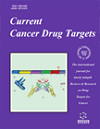- Home
- A-Z Publications
- Current Cancer Drug Targets
- Previous Issues
- Volume 25, Issue 1, 2025
Current Cancer Drug Targets - Volume 25, Issue 1, 2025
Volume 25, Issue 1, 2025
-
-
Insights into the Emerging Therapeutic Targets of Triple-negative Breast Cancer
More LessTriple-negative Breast Cancer (TNBC), the most aggressive breast cancer subtype, is characterized by the non-appearance of estrogen receptor (ER), progesterone receptor (PR), and human epidermal growth factor receptor 2 (HER2). Clinically, TNBC is marked by its low survival rate, poor therapeutic outcomes, high aggressiveness, and lack of targeted therapies. Over the past few decades, many clinical trials have been o Read More
-
-
-
DNA Methylation-based Diagnosis and Treatment of Breast Cancer
More LessAuthors: Xintong Peng, Jingfan Zheng, Tianzi Liu, Ziwen Zhou, Chen Song, Danyan Zhang, Xinlong Zhang and Yan HuangDNA methylation is a key epigenetic modifier involved in tumor formation, invasion, and metastasis. The development of breast cancer is a complex process, and many studies have now confirmed the involvement of DNA methylation in breast cancer. Moreover, the number of genes identified as aberrantly methylated in breast cancer is rapidly increasing, and the accumulation of epigenetic alterations becomes a chr Read More
-
-
-
An Overview of the Dichotomous Role of Microbiota in Cancer Progression and Management
More LessAuthors: Pooja Jain, Sradhanjali Mohapatra, Uzma Farooq, Nazia Hassan, Mohd. Aamir Mirza and Zeenat IqbalIt is a well-known fact that cancer is considered the second leading cause of mortality across the globe. Although the human oral cavity and intestine are the natural habitat of thousands of microbes, dysbiosis results in malignancies, such as oral squamous cell carcinoma and colorectal cancer. Amongst the intestinal microbes, H. pylori is a deadly carcinogen. Also, causative pathogens for the development of pancreatic Read More
-
-
-
Construction of an Oxidative Stress Risk Model to Analyze the Correlation Between Liver Cancer and Tumor Immunity
More LessAuthors: Ying Liu, Yufeng Li, Li Chen, Weina Zha, Jing Zhang, Kun Wang, Chunhai Hao and Jianhe GanBackgroundHepatocellular carcinoma (HCC) remains one of the most lethal cancers globally. Despite advancements in immunotherapy, the prognosis for patients with HCC continues to be poor. As oxidative stress plays a significant role in the onset and progression of various diseases, including metabolism-related HCC, comprehending its mechanism in HCC is critical for effective diagnosis and treatment.MethodsThis st Read More
-
-
-
Gender Matters. Sex-related Differences in Immunotherapy Outcome in Patients with Non-small Cell Lung Cancer
More LessBackgroundEmerging evidence identified sex as a variable regulating immune system functions and modulating response to immunotherapy in cancer patients.ObjectiveThis retrospective study analysed sex-related differences in immunotherapy outcomes in a real-world population of non-small cell lung cancer (NSCLC) patients treated with immune checkpoint inhibitors (ICIs).MethodsWe retrospectively investigated clinical Read More
-
-
-
TBOPP, a DOCK1 Inhibitor, Potentiates Cisplatin Efficacy in Breast Cancer by Regulating Twist-mediated EMT
More LessAuthors: Xin Chen, Zhenbang Zhou, Pengting Tang, Feiya Du, Shuqian Wang, Jia Yao, Shufen Zhang, Jiajing Huang, Xuemei Lu, Wei Chen, Xiaofang Yu, Yu Liu and Hao LiuBackgroundDOCK1 has been reported to be involved in tumor progression and resistance.1-(2-(30-(trifluoromethyl)-[1,10-biphenyl]-4-yl)-2-oxoethyl)-5-pyrrolidinylsulfonyl2(1H)- pyridone (TBOPP) is a selective DOCK1 inhibitor; however, the role and molecular mechanisms of DOCK1 and its inhibition in breast cancer (BC) resistance remain poorly understood. Objective: This study aims toinvestigate the underlying mechani Read More
-
-
-
Thyroid Metastases from Breast Cancer Case Report and Literature Review
More LessAuthors: Yumei Guan, Qinjun Ma, Yiqing Zhang, Jiuda Zhao and Xinjian GuoBackgroundThyroid metastasis arising from primary breast cancer is a rare phenomenon, with only a handful of cases documented in both national and international literature. The management approach and prognosis of this occurrence have sparked debates and uncertainties.Case PresentationHerein, we report the case of a 55-year-old woman with breast cancer. She previously underwent extensive excision of the Read More
-
-
-
Twenty-four-month Progression-free Survival in HER2-amplified Advanced Gastric Cancer with Brain Metastases after Trastuzumab Deruxtecan Treatment: A Case Report and Literature Review
More LessAuthors: Haibo Zhang and Min XuBackgroundTrastuzumab deruxtecan (T-DXd) has shown promising outcomes as a second or subsequent-line treatment for human epidermal growth factor-2 (HER2)-positive advanced gastric or gastroesophageal junction cancer.Case PresentationWe reported a 49-year-old male patient with stage IV HER2-amplified gastric cancer. Despite extensive pretreatments, including first-line trastuzumab plus FOLFOX, second-line Read More
-
Volumes & issues
-
Volume 25 (2025)
-
Volume 24 (2024)
-
Volume 23 (2023)
-
Volume 22 (2022)
-
Volume 21 (2021)
-
Volume 20 (2020)
-
Volume 19 (2019)
-
Volume 18 (2018)
-
Volume 17 (2017)
-
Volume 16 (2016)
-
Volume 15 (2015)
-
Volume 14 (2014)
-
Volume 13 (2013)
-
Volume 12 (2012)
-
Volume 11 (2011)
-
Volume 10 (2010)
-
Volume 9 (2009)
-
Volume 8 (2008)
-
Volume 7 (2007)
-
Volume 6 (2006)
-
Volume 5 (2005)
-
Volume 4 (2004)
-
Volume 3 (2003)
-
Volume 2 (2002)
-
Volume 1 (2001)
Most Read This Month
Article
content/journals/ccdt
Journal
10
5
false
en


